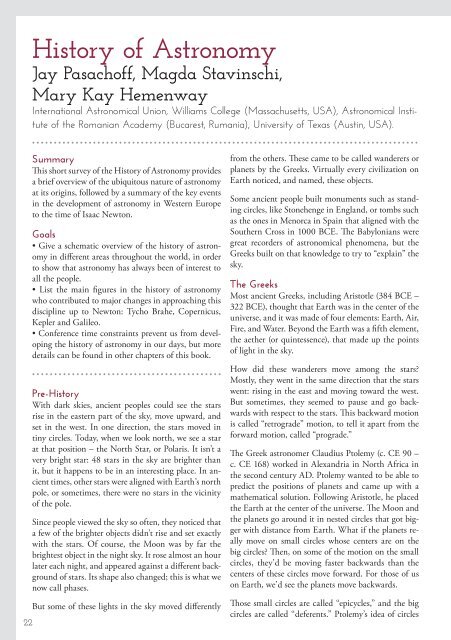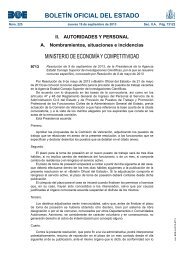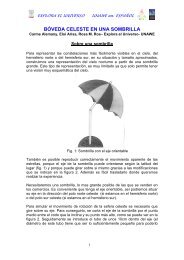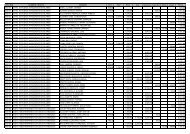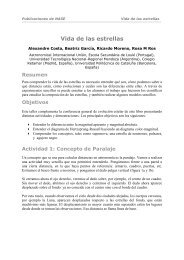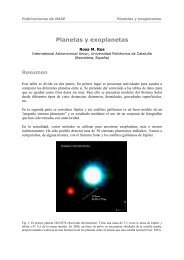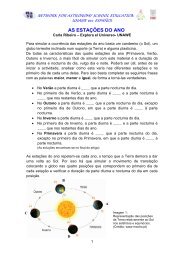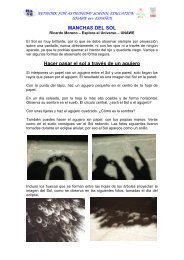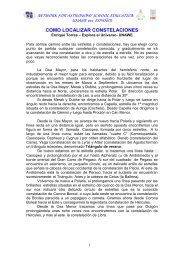History of Astronomy Jay Pasachoff, Magda Stavinschi ... - sac.csic.es
History of Astronomy Jay Pasachoff, Magda Stavinschi ... - sac.csic.es
History of Astronomy Jay Pasachoff, Magda Stavinschi ... - sac.csic.es
Create successful ePaper yourself
Turn your PDF publications into a flip-book with our unique Google optimized e-Paper software.
22<br />
<strong>History</strong> <strong>of</strong> <strong>Astronomy</strong><br />
<strong>Jay</strong> Pa<strong>sac</strong>h<strong>of</strong>f, <strong>Magda</strong> <strong>Stavinschi</strong>,<br />
Mary Kay Hemenway<br />
International Astronomical Union, Williams College (Mas<strong>sac</strong>husetts, USA), Astronomical Institute<br />
<strong>of</strong> the Romanian Academy (Bucar<strong>es</strong>t, Rumania), University <strong>of</strong> Texas (Austin, USA).<br />
����������������������������������������������������������������������������������������������������������������������������������������������������������������������������������<br />
Summary<br />
�is short survey <strong>of</strong> the <strong>History</strong> <strong>of</strong> <strong>Astronomy</strong> provid<strong>es</strong><br />
a brief overview <strong>of</strong> the ubiquitous nature <strong>of</strong> astronomy<br />
at its origins, followed by a summary <strong>of</strong> the key events<br />
in the development <strong>of</strong> astronomy in W<strong>es</strong>tern Europe<br />
to the time <strong>of</strong> Isaac Newton.<br />
Goals<br />
����������������������������������������������������omy<br />
in different areas throughout the world, in order<br />
to show that astronomy has always been <strong>of</strong> inter<strong>es</strong>t to<br />
all the people.<br />
�� ����� ���� ����� ������� ��� ���� �������� ��� ����������<br />
who contributed to major chang<strong>es</strong> in approaching this<br />
discipline up to Newton: Tycho Brahe, Copernicus,<br />
Kepler and Galileo.<br />
���������������������������������������������������oping<br />
the history <strong>of</strong> astronomy in our days, but more<br />
details can be found in other chapters <strong>of</strong> this book.<br />
�������������������������������������������������������������������������������������<br />
Pre-<strong>History</strong><br />
With dark ski<strong>es</strong>, ancient peopl<strong>es</strong> could see the stars<br />
rise in the eastern part <strong>of</strong> the sky, move upward, and<br />
set in the w<strong>es</strong>t. In one direction, the stars moved in<br />
tiny circl<strong>es</strong>. Today, when we look north, we see a star<br />
at that position – the North Star, or Polaris. It isn’t a<br />
very bright star: 48 stars in the sky are brighter than<br />
it, but it happens to be in an inter<strong>es</strong>ting place. In ancient<br />
tim<strong>es</strong>, other stars were aligned with Earth’s north<br />
pole, or sometim<strong>es</strong>, there were no stars in the vicinity<br />
<strong>of</strong> the pole.<br />
Since people viewed the sky so <strong>of</strong>ten, they noticed that<br />
a few <strong>of</strong> the brighter objects didn’t rise and set exactly<br />
with the stars. Of course, the Moon was by far the<br />
bright<strong>es</strong>t object in the night sky. It rose almost an hour<br />
later each night, and appeared against a different background<br />
<strong>of</strong> stars. Its shape also changed; this is what we<br />
now call phas<strong>es</strong>.<br />
But some <strong>of</strong> th<strong>es</strong>e lights in the sky moved differently<br />
from the others. �<strong>es</strong>e came to be called wanderers or<br />
planets by the Greeks. Virtually every civilization on<br />
Earth noticed, and named, th<strong>es</strong>e objects.<br />
Some ancient people built monuments such as standing<br />
circl<strong>es</strong>, like Stonehenge in England, or tombs such<br />
as the on<strong>es</strong> in Menorca in Spain that aligned with the<br />
Southern Cross in 1000 BCE. �e Babylonians were<br />
great recorders <strong>of</strong> astronomical phenomena, but the<br />
Greeks built on that knowledge to try to “explain” the<br />
sky.<br />
The Greeks<br />
Most ancient Greeks, including Aristotle (384 BCE –<br />
322 BCE), thought that Earth was in the center <strong>of</strong> the<br />
universe, and it was made <strong>of</strong> four elements: Earth, Air,<br />
Fire, and Water. Beyond the Earth was a fifth element,<br />
the aether (or quint<strong>es</strong>sence), that made up the points<br />
<strong>of</strong> light in the sky.<br />
How did th<strong>es</strong>e wanderers move among the stars?<br />
Mostly, they went in the same direction that the stars<br />
went: rising in the east and moving toward the w<strong>es</strong>t.<br />
But sometim<strong>es</strong>, they seemed to pause and go backwards<br />
with r<strong>es</strong>pect to the stars. �is backward motion<br />
is called “retrograde” motion, to tell it apart from the<br />
forward motion, called “prograde.”<br />
�e Greek astronomer Claudius Ptolemy (c. CE 90 –<br />
c. CE 168) worked in Alexandria in North Africa in<br />
the second century AD. Ptolemy wanted to be able to<br />
predict the positions <strong>of</strong> planets and came up with a<br />
mathematical solution. Following Aristotle, he placed<br />
the Earth at the center <strong>of</strong> the universe. �e Moon and<br />
the planets go around it in n<strong>es</strong>ted circl<strong>es</strong> that got bigger<br />
with distance from Earth. What if the planets really<br />
move on small circl<strong>es</strong> whose centers are on the<br />
big circl<strong>es</strong>? �en, on some <strong>of</strong> the motion on the small<br />
circl<strong>es</strong>, they’d be moving faster backwards than the<br />
centers <strong>of</strong> th<strong>es</strong>e circl<strong>es</strong> move forward. For those <strong>of</strong> us<br />
on Earth, we’d see the planets move backwards.<br />
�ose small circl<strong>es</strong> are called “epicycl<strong>es</strong>,” and the big<br />
circl<strong>es</strong> are called “deferents.” Ptolemy’s idea <strong>of</strong> circl<strong>es</strong>
moving on circl<strong>es</strong> held sway over w<strong>es</strong>tern science for<br />
over a thousand years. Going from observation to theory<br />
using mathematics was a unique and important<br />
step in the development <strong>of</strong> w<strong>es</strong>tern science.<br />
Although they didn’t have the same nam<strong>es</strong> for the objects<br />
they observed, virtually every culture on Earth<br />
watched the ski<strong>es</strong>. �ey used the information to set<br />
up calendars and predict the seasonal cycl<strong>es</strong> for planting,<br />
harv<strong>es</strong>ting, or hunting as well as religious ceremoni<strong>es</strong>.<br />
Like the Greeks, some <strong>of</strong> them developed very<br />
sophisticated mathematics to predict the motions <strong>of</strong><br />
the planets or eclips<strong>es</strong>, but this do<strong>es</strong> not mean that<br />
they attempted what we would call a scientific theory.<br />
Here are some exampl<strong>es</strong>:<br />
Africa<br />
�e standing ston<strong>es</strong> at Nabta in the Nubian D<strong>es</strong>ert<br />
pre-date Stonehenge by 1000 years. Egyptians used<br />
astronomy to align their pyramids as well as extend<br />
their religious beliefs to include star lore. Petroglyphs<br />
at Namoratunga (Kenya) share aspects <strong>of</strong> modern cattle<br />
brands. Star lore com<strong>es</strong> from all areas <strong>of</strong> Africa,<br />
from the Dogon region <strong>of</strong> Mali, to W<strong>es</strong>t Africa, to<br />
Ethiopia, to South Africa.<br />
Islamic <strong>Astronomy</strong><br />
Many astronomical developments were made in the<br />
Islamic world, particularly during the Islamic Golden<br />
Age (8th-15th centuri<strong>es</strong>), and mostly written in the<br />
Arabic language. It was developed most in the Middle<br />
East, Central Asia, Al-Andalus, North Africa, and<br />
later in the Far East and India. A significant number<br />
<strong>of</strong> stars in the sky, such as Aldebaran and Altair, and<br />
astronomical terms such as alidade, azimuth, almucantar,<br />
are still referred to by their Arabic nam<strong>es</strong>.<br />
Arabs invented Arabic numbers, including the use <strong>of</strong><br />
zero. �ey were inter<strong>es</strong>ted in finding positions and<br />
time <strong>of</strong> day (since it was useful for prayer servic<strong>es</strong>).<br />
�ey made many discoveri<strong>es</strong> in optics as well. Many<br />
works in Greek were pr<strong>es</strong>erved for posterity through<br />
their translations to Arabic.<br />
�e first systematic observations in Islam are reported<br />
to have taken place under the patronage <strong>of</strong> Al-Maâmun<br />
(786-833 CE). Here, and in many other private<br />
observatori<strong>es</strong> from Damascus to Baghdad, meridian<br />
degre<strong>es</strong> were measured, solar parameters were <strong>es</strong>tablished,<br />
and detailed observations <strong>of</strong> the Sun, Moon,<br />
and planets were undertaken.<br />
Instruments used by the Islamic astronomy were: cel<strong>es</strong>tial<br />
glob<strong>es</strong> and armillary spher<strong>es</strong>, astrolab<strong>es</strong>, sundials<br />
and quadrants.<br />
Fig. 1: Arabic astrolabe.<br />
The Americas<br />
North America<br />
Native peopl<strong>es</strong> <strong>of</strong> North America also named their<br />
constellations and told sky stori<strong>es</strong> which were passed<br />
down through oral tradition. Some artifacts, such as<br />
stone wheels or building alignments, remain as evidence<br />
<strong>of</strong> their use <strong>of</strong> astronomy in every-day life.<br />
Mayan <strong>Astronomy</strong><br />
�e Maya were a M<strong>es</strong>oamerican civilization, noted<br />
for the only known fully developed written language<br />
<strong>of</strong> the pre-Columbian Americas, as well as for its art,<br />
architecture, mathematical and astronomical systems.<br />
Initially <strong>es</strong>tablished during the Pre-Classic period (c.<br />
2000 BCE to 250 CE), Mayan citi<strong>es</strong> reached their<br />
high<strong>es</strong>t state <strong>of</strong> development during the Classic period<br />
(c. 250 CE to 900 CE), and continued throughout<br />
the Post-Classic period until the arrival <strong>of</strong> the Spanish.<br />
�e Mayan peopl<strong>es</strong> never disappeared, neither at<br />
the time <strong>of</strong> the Classic period decline nor with the arrival<br />
<strong>of</strong> the Spanish conquistadors and the subsequent<br />
Spanish colonization <strong>of</strong> the Americas.<br />
Mayan astronomy is one <strong>of</strong> the most known ancient<br />
astronomi<strong>es</strong> in the world, <strong>es</strong>pecially due to its famous<br />
calendar, wrongly interpreted now as predicting the<br />
end <strong>of</strong> the world. Maya appear to be the only pretel<strong>es</strong>copic<br />
civilization to demonstrate knowledge <strong>of</strong><br />
the Orion Nebula as being fuzzy, i.e. not a stellar pinpoint.<br />
�e Maya were very inter<strong>es</strong>ted in zenithal passag<strong>es</strong>,<br />
the time when the Sun pass<strong>es</strong> directly overhead. �e<br />
latitud<strong>es</strong> <strong>of</strong> most <strong>of</strong> their citi<strong>es</strong> being below the Tropic<br />
<strong>of</strong> Cancer, th<strong>es</strong>e zenithal passag<strong>es</strong> would occur twice<br />
a year equidistant from the solstice. To repr<strong>es</strong>ent this<br />
position <strong>of</strong> the Sun overhead, the Maya had a god<br />
named Diving God.<br />
23
Fig. 2: Chichén Itzá(Mexico) is an important archaeological<br />
remains <strong>of</strong> the Maya astronomy.<br />
Venus was the most important astronomical object to<br />
the Maya, even more important to them than the Sun.<br />
�e Mayan calendar is a system <strong>of</strong> calendars and almanacs<br />
used in the Mayan civilization <strong>of</strong> pre-Columbian<br />
M<strong>es</strong>oamerica, and in some modern Maya communiti<strong>es</strong><br />
in highland Guatemala and Oaxaca, Mexico.<br />
Although the M<strong>es</strong>oamerican calendar did not originate<br />
with the Mayan, their subsequent extensions and<br />
refinements <strong>of</strong> it were the most sophisticated. Along<br />
with those <strong>of</strong> the Aztecs, the Mayan calendars are the<br />
b<strong>es</strong>t documented and most completely understood.<br />
Aztec <strong>Astronomy</strong><br />
�ey were certain ethnic groups <strong>of</strong> central Mexico,<br />
particularly those groups who spoke the Nahuatl language<br />
and who dominated large parts <strong>of</strong> M<strong>es</strong>oamerica<br />
in the 14th, 15th and 16th centuri<strong>es</strong>, a period referred<br />
to as the late post-classic period in M<strong>es</strong>oamerican<br />
chronology.<br />
Aztec culture and history is primarily known through<br />
archeological evidence found in excavations such as<br />
that <strong>of</strong> the renowned Templo Mayor in Mexico City<br />
and many others, from indigenous bark paper codic<strong>es</strong>,<br />
from eyewitn<strong>es</strong>s accounts by Spanish conquistadors or<br />
16th and 17th century d<strong>es</strong>criptions <strong>of</strong> Aztec culture<br />
and history written by Spanish clergymen and literate<br />
Aztecs in the Spanish or Nahuatl language.<br />
�e Aztec Calendar, or Sun Stone, is the earli<strong>es</strong>t<br />
monolith that remains <strong>of</strong> the pre-Hispanic culture in<br />
Central and South America. It is believed that it was<br />
carved around the year 1479. �is is a circular monolith<br />
with four concentric circl<strong>es</strong>. In the center appears<br />
the face <strong>of</strong> Tonatiuh (Sun God), decorated with jade<br />
and holding a knife in his mouth. �e four suns or<br />
earlier “worlds” are repr<strong>es</strong>ented by square-shaped figur<strong>es</strong><br />
flanking the Fifth Sun, in the center. �e outer<br />
circle consists <strong>of</strong> 20 areas that repr<strong>es</strong>ent the days <strong>of</strong><br />
each <strong>of</strong> the 18 months that comprised the Aztec calendar.<br />
To complete the 365-day solar year, the Aztecs<br />
24<br />
incorporated 5 <strong>sac</strong>rificial, or Nemontemi, days.<br />
Like almost all ancient peopl<strong>es</strong>, the Aztecs grouped<br />
into associations the apparent bright stars (constellations):<br />
Mamalhuaztli (Orion’s Belt), Tianquiztli (the<br />
Pleiad<strong>es</strong>), Citlaltlachtli (Gemini), Citlalcolotl (Scorpio)<br />
and Xonecuilli (�e Little Dipper, or Southern<br />
Cross for others, etc.). Comets were called “the stars<br />
that smoke”.<br />
�e great periods <strong>of</strong> time in the Aztec cosmology are<br />
defined by the eras <strong>of</strong> different suns, each <strong>of</strong> whose end<br />
was determined by major disasters such as d<strong>es</strong>truction<br />
by jaguars, hurrican<strong>es</strong>, fire, flood or earthquak<strong>es</strong>.<br />
Inca <strong>Astronomy</strong><br />
Inca civilization is a civilization pre-Columbian Andean<br />
Group. It starts at the beginning <strong>of</strong> the 13th century<br />
in the basin <strong>of</strong> Cuzco in Peru and the current then<br />
grows along the Pacific Ocean and the And<strong>es</strong>, covering<br />
the w<strong>es</strong>tern part <strong>of</strong> South America. At its peak, it<br />
extends from Colombia to Argentina and Chile, across<br />
Ecuador, Peru and Bolivia.<br />
�e Incas considered their King, the Sapa Inca, to be<br />
the “child <strong>of</strong> the Sun”. Its members identified various<br />
dark areas or dark nebulae in the Milky Way as animals,<br />
and associated their appearance with the seasonal<br />
rains. Its members identified various dark areas or<br />
dark nebulae in the Milky Way as animals, and associated<br />
their appearance with the seasonal rains<br />
�e Incas used a solar calendar for agriculture and a<br />
lunar calendar for the religious holidays. According to<br />
chronicl<strong>es</strong> <strong>of</strong> the Spanish conquistadors, on the outskirts<br />
<strong>of</strong> Cuzco in pr<strong>es</strong>ent day Peru there was a big<br />
public schedule that consisted <strong>of</strong> 12 columns each 5<br />
meters high that could be seen from afar. With it, people<br />
could set the date. �ey celebrated two major parti<strong>es</strong>,<br />
the Inti Raymi and Capac Raymi, the summer<br />
and winter solstice r<strong>es</strong>pectively.<br />
�ey had their own constellations: the Yutu (Partridge)<br />
was the dark zone in the Milky Way that we<br />
call the Coal Sack. �ey called the Pleiad<strong>es</strong> cluster<br />
Qollqa. With the stars <strong>of</strong> the Lyra constellation they<br />
did a drawing <strong>of</strong> one <strong>of</strong> the most known animals to<br />
them, and named it Little Silver Llama or colored<br />
Llama, whose bright<strong>es</strong>t star (Vega) was Urkuchillay,<br />
although according to others, that was the name <strong>of</strong> the<br />
whole constellation. Moreover there were the Machacuay<br />
(snake), the Hamp’atu (toad), the Atoq (Fox), the<br />
Kuntur, etc.<br />
Major citi<strong>es</strong> were drawn following cel<strong>es</strong>tial alignments<br />
and using the cardinal points.
On the outskirts <strong>of</strong> Cuzco there was an important<br />
temple dedicated to the Sun (Inti), from which came<br />
out some lin<strong>es</strong> in radial shape that divided the valley<br />
in 328 Templ<strong>es</strong>. �at number is still a mystery, but<br />
one possible explanation relat<strong>es</strong> it to the astronomy:<br />
it coincid<strong>es</strong> with the days that contain twelve lunar<br />
months. And the 37 days that are missing until the<br />
365 days <strong>of</strong> the solar year coincid<strong>es</strong> with the days that<br />
the Pleiad<strong>es</strong> cluster is not observable from Cuzco.<br />
India<br />
�e earli<strong>es</strong>t textual mention that is given in the religious<br />
literature <strong>of</strong> India (2nd millennium BCE) became<br />
an <strong>es</strong>tablished tradition by the 1st millennium<br />
BCE, when different ancillary branch<strong>es</strong> <strong>of</strong> learning<br />
began to take shape.<br />
During the following centuri<strong>es</strong> a number <strong>of</strong> Indian<br />
astronomers studied various aspects <strong>of</strong> astronomical<br />
scienc<strong>es</strong>, and global discourse with other cultur<strong>es</strong> followed.<br />
Gnomons and armillary spher<strong>es</strong> were common<br />
instruments.<br />
�e Hindu calendar used in ancient tim<strong>es</strong> has undergone<br />
many chang<strong>es</strong> in the proc<strong>es</strong>s <strong>of</strong> regionalization,<br />
and today there are several regional Indian calendars,<br />
as well as an Indian national calendar. In the Hindu<br />
calendar, the day starts with local sunrise. It is allotted<br />
five “properti<strong>es</strong>,” called angas.<br />
�e ecliptic is divided into 27 nakshatras, which are<br />
variously called lunar hous<strong>es</strong> or asterisms. �<strong>es</strong>e reflect<br />
the moon’s cycle against the fixed stars, 27 days and<br />
72 hours, the fractional part being compensated by an<br />
intercalary 28th nakshatra. Nakshatra computation<br />
appears to have been well known at the time <strong>of</strong> the<br />
Rig Veda (2nd to 1st millennium BCE).<br />
China<br />
�e Chin<strong>es</strong>e were considered as the most persistent<br />
and accurate observers <strong>of</strong> cel<strong>es</strong>tial phenomena anywhere<br />
in the world before the Arabs. Detailed records<br />
<strong>of</strong> astronomical observations began during the Warring<br />
Sat<strong>es</strong> period (4th century BCE) and flourished<br />
from the Han period onwards.<br />
Some elements <strong>of</strong> Indian astronomy reached China<br />
with the expansion <strong>of</strong> Buddhism during the Later Han<br />
dynasty (25-220 CE), but the most detailed incorporation<br />
<strong>of</strong> Indian astronomical thought occurred during<br />
the Tang Dynasty (618-907).<br />
<strong>Astronomy</strong> was revitalized under the stimulus <strong>of</strong> W<strong>es</strong>tern<br />
cosmology and technology after the J<strong>es</strong>uits <strong>es</strong>tablished<br />
their missions. �e tel<strong>es</strong>cope was introduced in<br />
the 17th century. Equipment and innovation used by<br />
Chin<strong>es</strong>e astronomy: armillary sphere, cel<strong>es</strong>tial globe,<br />
the water-powered armillary sphere and the cel<strong>es</strong>tial<br />
globe tower.<br />
Chin<strong>es</strong>e astronomy was focused more on the observations<br />
than on theory. According to writings <strong>of</strong> the<br />
J<strong>es</strong>uits, who visited Beijing in the 17th century, the<br />
Chin<strong>es</strong>e had data from the year 4,000 BCE, including<br />
the explosion <strong>of</strong> supernovae, eclips<strong>es</strong> and the appearance<br />
<strong>of</strong> comets.<br />
In the year 2300 BCE, they developed the first known<br />
solar calendar, and in 2100 BCE recorded a solar<br />
eclipse. In 1200 BCE they d<strong>es</strong>cribed sunspots, calling<br />
them “specks dark” in the Sun. In 532 BCE, they<br />
left evidence <strong>of</strong> the emergence <strong>of</strong> a supernova star in<br />
the Aquila constellation, and in the 240 and 164 BCE<br />
passag<strong>es</strong> <strong>of</strong> Halley comet. In 100 BCE Chin<strong>es</strong>e invented<br />
the compass with which they marked the direction<br />
north.<br />
And in more recent tim<strong>es</strong>, they determined the prec<strong>es</strong>sion<br />
<strong>of</strong> the equinox<strong>es</strong> as one degree every 50 years,<br />
recorded more supernovae and found that the tail <strong>of</strong><br />
comets always points in the opposite direction to the<br />
Sun’s position<br />
In the year 1006 CE they noted the appearance <strong>of</strong> a<br />
supernova so bright that could be seen during the day.<br />
It is the bright<strong>es</strong>t supernova that has been reported.<br />
And in 1054, they observed a supernova, the remnants<br />
<strong>of</strong> which would later be called the Crab Nebula.<br />
�eir cel<strong>es</strong>tial sphere differed from the W<strong>es</strong>tern one.<br />
�e cel<strong>es</strong>tial equator was divided into 28 parts, called<br />
“hous<strong>es</strong>”, and there were a total <strong>of</strong> 284 constellations<br />
with nam<strong>es</strong> such as Dipper, �ree Steps, Supreme Palace,<br />
Tripod, Spear or Harpoon. Chin<strong>es</strong>e New Year<br />
starts on the day <strong>of</strong> the first new moon after the sun<br />
enters the constellation Aquarius.<br />
�e polymath Chin<strong>es</strong>e scientist Shen Kuo (1031-1095<br />
CE) was not only the first in history to d<strong>es</strong>cribe the<br />
magnetic-needle compass, but also made a more accurate<br />
measurement <strong>of</strong> the distance between the Pole<br />
Star and true North that could be used for navigation.<br />
Shen Kuo and Wei Pu also <strong>es</strong>tablished a project <strong>of</strong><br />
nightly astronomical observation over a period <strong>of</strong> five<br />
succ<strong>es</strong>sive years, an intensive work that would even rival<br />
the later work <strong>of</strong> Tycho Brahe in Europe. �ey also<br />
charted the exact coordinat<strong>es</strong> <strong>of</strong> the planets on a star<br />
map for this project and created theori<strong>es</strong> <strong>of</strong> planetary<br />
motion, including retrograde motion.<br />
25
Europa Occidental<br />
Following the fall <strong>of</strong> Rome, the knowledge complied<br />
by the Greeks was barely transmitted through the work<br />
<strong>of</strong> monks who <strong>of</strong>ten copied manuscripts that held no<br />
meaning for them. Eventually, with the rise <strong>of</strong> Cathedral<br />
schools and the first universiti<strong>es</strong>, scholars started<br />
to tackle the puzzl<strong>es</strong> that science <strong>of</strong>fers. �rough trade<br />
(and pillaging), new manuscripts from the East came<br />
through the Crusad<strong>es</strong>, and contact with Islamic scholars<br />
(<strong>es</strong>pecially in Spain) allowed translations to Latin<br />
to be made. Some scholars attempted to pull the information<br />
into an order that would fit it into their Christian<br />
viewpoint.<br />
Mathematical genius: Nicholas Copernicus<br />
<strong>of</strong> Poland<br />
In the early 1500s, Nicholas Copernicus (1473 ‒ 1543)<br />
concluded that Universe would be simpler if the Sun,<br />
rather than the Earth, were at its center. �en the retrograde<br />
motion <strong>of</strong> the planets would occur even if all<br />
the planets merely orbited the Sun in circl<strong>es</strong>. �e backward<br />
motion would be an optical illusion that r<strong>es</strong>ulted<br />
when we passed another planet. Similarly, if you look<br />
at the car to your right while you are both stopped at a<br />
traffic light, if you start moving first, you might briefly<br />
think that the other car is moving backwards.<br />
Copernicus shared his ideas with mathematicians, but<br />
did not publish them until a young scientist, Georg<br />
Rheticus, convinced him and arranged for the publication<br />
in another town. A printed copy <strong>of</strong> De Revolutionibus<br />
Orbium Cel<strong>es</strong>tium arrived just as Copernicus<br />
was dying in 1543. He may have never seen the unsigned<br />
preface written by the publisher that sugg<strong>es</strong>ted<br />
that the book was a mathematical way to calculate positions,<br />
not the actual truth. Following Aristotle, Copernicus<br />
used circl<strong>es</strong> and added some epicycl<strong>es</strong>. His<br />
book followed the structure <strong>of</strong> Ptolemy’s book, but his<br />
devotion to mathematical simplicity was influenced by<br />
Pythagorus.<br />
Copernicus’s book contains (figure 3) perhaps the most<br />
famous diagram in the history <strong>of</strong> science. It shows the<br />
Sun at the center <strong>of</strong> a seri<strong>es</strong> <strong>of</strong> circl<strong>es</strong>. Copernicus calculated<br />
the speeds at which the planets went around<br />
the Sun, since he knew which went fast<strong>es</strong>t in the sky.<br />
�us he got the planets in the correct order: Mercury,<br />
Venus, Earth, Mars, Jupiter, Saturn, and he got the<br />
relative distanc<strong>es</strong> <strong>of</strong> the planets correct also. But, his<br />
calculations really didn’t predict the positions <strong>of</strong> the<br />
planets much better than Ptolemy’s method did.<br />
In England, Leonard Digg<strong>es</strong> wrote a book, in English,<br />
about the Earth and the Universe. In 1576, his<br />
son �omas wrote an appendix in which he d<strong>es</strong>cribed<br />
26<br />
Fig. 3. Copernicus’s diagram first showing the Sun at<br />
the center <strong>of</strong> what we therefore now call the Solar<br />
System. This diagram is from the first edition <strong>of</strong> De<br />
Revolutionibus Orbium Cel<strong>es</strong>tium (On the Revolutions<br />
<strong>of</strong> the Cel<strong>es</strong>tial Orbs), published in 1543.<br />
Copernicus’s new ideas. In the appendix, an Englishlanguage<br />
version <strong>of</strong> Copernicus’s diagram appeared for<br />
the first time (figure 4). Digg<strong>es</strong> also showed the stars<br />
at many different distanc<strong>es</strong> from the solar system, not<br />
just in one cel<strong>es</strong>tial sphere.<br />
Observational genius: Tycho Brahe <strong>of</strong> Denmark<br />
Fig. 4. The first Copernican diagram in English, from<br />
Thomas Digg<strong>es</strong>’s appendix to A prognostication everlasting,<br />
a book by his father first published in 1556.<br />
It contained only a Ptolemaic diagram. Thomas Digg<strong>es</strong>’s<br />
appendix first appeared in 1576; this diagram is<br />
from the 1596 printing.
�e Danish aristocrat Tycho Brahe (1546 – 1601)<br />
took over an island <strong>of</strong>f the coast <strong>of</strong> Copenhagen, and<br />
received rent from the people there. On this island,<br />
Hven, he used his wealth to build a great observatory<br />
with larger and better instruments. �ough th<strong>es</strong>e were<br />
pre-tel<strong>es</strong>copic instruments, they were notable for allowing<br />
more precise measurements <strong>of</strong> the positions <strong>of</strong><br />
the stars and planets than had previously been possible.<br />
Tycho ran his home as a forerunner <strong>of</strong> today’s university,<br />
with visiting scientists coming to work with<br />
him. He made better and better observing devic<strong>es</strong> to<br />
measure the positions <strong>of</strong> stars and planets, and kept<br />
accurate records.<br />
But in his scientific zeal, he neglected some <strong>of</strong> his duti<strong>es</strong><br />
to his monarch, and when a new king and queen came<br />
in, he was forced out. He chose to move to Prague,<br />
on the continent <strong>of</strong> Europe, taking even his printing<br />
pr<strong>es</strong>s<strong>es</strong> and pag<strong>es</strong> that had already been printed, his<br />
records, and his moveable tools.<br />
Tycho succeeded in improving the accuracy <strong>of</strong> scientific<br />
observations. His accurate observations <strong>of</strong> a comet<br />
at various distanc<strong>es</strong> showed him that the spher<strong>es</strong> did<br />
not have to be n<strong>es</strong>ted with the Earth at the center.<br />
So, he made his own model <strong>of</strong> the universe -a hybrid<br />
between Ptolemy’s and Copernicus’: the Sun and the<br />
Moon revolve around the Earth, while the other planets<br />
revolve around the Sun. Tycho still had circl<strong>es</strong>, but<br />
unlike Aristotle, he allowed the circl<strong>es</strong> to cross each<br />
other.<br />
We value Tycho mainly for the trove <strong>of</strong> high-quality<br />
observations <strong>of</strong> the positions among the stars <strong>of</strong> the<br />
planet Mars. To join him in Prague, Tycho invited a<br />
young mathematician, Johann<strong>es</strong> Kepler. It is through<br />
Kepler that Tycho’s fame largely remains.<br />
Using Mathematics: Johann<strong>es</strong> Kepler <strong>of</strong> Germany<br />
As a teacher in Graz, Austria, young Johann<strong>es</strong> Kepler<br />
(1571 – 1630) remembered his childhood inter<strong>es</strong>t in<br />
astronomy, fostered by a comet and the lunar eclipse<br />
that he had seen. He realized that there are five solid<br />
forms made <strong>of</strong> equally-shaped sid<strong>es</strong>, and that if th<strong>es</strong>e<br />
solids were n<strong>es</strong>ted and separated by spher<strong>es</strong>, they could<br />
corr<strong>es</strong>pond to the six known planets. His book on the<br />
subject, Mysterium Cosmographicum (Mystery <strong>of</strong> the<br />
Cosmos), published in 1596, contained one <strong>of</strong> the most<br />
beautiful diagrams in the history <strong>of</strong> science (figure 5).<br />
In it, he n<strong>es</strong>ted an octahedron, icosahedron, dodecahedron,<br />
tetrahedron, and cube, with eight, twelve, twenty,<br />
four, and six sid<strong>es</strong>, r<strong>es</strong>pectively, to show the spacing<br />
<strong>of</strong> the then-known planets. �e diagram, though very<br />
Fig. 5: Kepler’s foldout diagram from his Mysterium<br />
Cosmographicum (Mystery <strong>of</strong> the Cosmos),<br />
published in 1596. His thinking <strong>of</strong> the geometric arrangement<br />
<strong>of</strong> the solar system was superseded in<br />
the following decade by his arrangements <strong>of</strong> the<br />
planets according to the first two <strong>of</strong> his three laws<br />
<strong>of</strong> planetary motion, a system we hold valid up to<br />
this day.<br />
beautiful, is completely wrong.<br />
But Kepler’s mathematical skill earned him an interview<br />
with Tycho. In 1600, he became one <strong>of</strong> several<br />
assistants to Tycho, and he made calculations using<br />
the data that Tycho had amassed. �en Tycho went<br />
to a formal dinner and drank liberally. As the story<br />
go<strong>es</strong>, etiquette prevented him from leaving the table,<br />
and he wound up with a burst bladder. His quick and<br />
painful death was carefully followed in a diary, and is<br />
well documented.<br />
But Kepler didn’t get the data right away. For one<br />
thing, the data was one <strong>of</strong> the few valuable things that<br />
Tycho’s children could inherit, since Tycho had married<br />
a commoner and was not allowed to bequeath<br />
real property. But Kepler did eventually get acc<strong>es</strong>s to<br />
Tycho’s data for Mars, and he tried to make it fit his<br />
calculations. To make his precise calculations, Kepler<br />
even worked out his own table <strong>of</strong> logarithms.<br />
�e data Kepler had from Tycho was <strong>of</strong> the position<br />
<strong>of</strong> the Mars in the sky, against a background <strong>of</strong> stars.<br />
He tried to calculate what its real motion around the<br />
Sun must be. For a long while, he tried to fit a circle<br />
or an egg-shaped orbit, but he just couldn’t match the<br />
observations accurately enough. Eventually, he tried a<br />
27
28<br />
geometrical figure called an ellipse, a sort <strong>of</strong> squashed<br />
circle. It fit! �e discovery is one <strong>of</strong> the great<strong>es</strong>t in the<br />
history <strong>of</strong> astronomy, and though Kepler first applied<br />
it to Mars and other planets in our solar system, we<br />
now apply it even to the hundreds <strong>of</strong> planets we have<br />
discovered around other stars.<br />
Kepler’s book <strong>of</strong> 1609, Astronomia Nova (�e New<br />
<strong>Astronomy</strong>), contained the first two <strong>of</strong> his three laws<br />
<strong>of</strong> motion:<br />
Kepler’s first law: �e planets orbit the Sun in ellips<strong>es</strong>,<br />
with the Sun at one focus.<br />
Kepler’s second law: A line joining a planet and the Sun<br />
sweeps out equal areas in equal tim<strong>es</strong>.<br />
An ellipse is a closed curve that has two key points<br />
in it; they are known as the foci. To draw your own<br />
ellipse, put two dots on a piece <strong>of</strong> paper; each is a<br />
focus. �en take a piece <strong>of</strong> string longer than the<br />
distance between the foci. Tape them down on the<br />
foci. Next, put a pencil in the string, pulling it taut,<br />
and gently move it from side to side. �e curve you<br />
generate will be one side <strong>of</strong> an ellipse; it is obvious<br />
how to move the pencil to draw the other side. �is<br />
experiment with the string shows one <strong>of</strong> the key points<br />
defining an ellipse: the sum <strong>of</strong> the distanc<strong>es</strong> from<br />
a point on the ellipse to each focus remains constant.<br />
A circle is a special kind <strong>of</strong> ellipse where the two dots<br />
are on top <strong>of</strong> each other.<br />
Kepler kept searching for harmoni<strong>es</strong> in the motions<br />
<strong>of</strong> the planets. He associated the speeds <strong>of</strong> the planets<br />
with musical not<strong>es</strong>, the higher not<strong>es</strong> corr<strong>es</strong>ponding to<br />
the faster-moving planets, namely, Mercury and Venus.<br />
In 1619, he published his major work Harmonic<strong>es</strong><br />
Mundi (�e Harmony <strong>of</strong> the Worlds). In it (figure<br />
6), he included not only musical staffs with not<strong>es</strong> but<br />
Fig. 6: From Kepler’s Harmonic<strong>es</strong> Mundi (The Harmony<br />
<strong>of</strong> the World), published in 1619.<br />
also what we call his third law <strong>of</strong> planetary motion:<br />
Kepler’s �ird Law <strong>of</strong> Planetary Motion: �e square<br />
<strong>of</strong> the period <strong>of</strong> a planet’s orbit around the sun is<br />
proportional to the cube <strong>of</strong> the size <strong>of</strong> its orbit.<br />
Astronomers tend to measure distanc<strong>es</strong> between planets<br />
in terms <strong>of</strong> the Astronomical Units, which corr<strong>es</strong>ponds<br />
to the average distance between the Earth and<br />
the Sun, or 150 million kilometers.<br />
Mercury 0.387 AU 0.240 years<br />
Venus 0.723 AU 0.615 years<br />
Earth 1 AU 1 year<br />
Mars 1.523 AU 1.881 years<br />
Jupiter 5.203 AU 11.857years<br />
Saturn 9.537 AU 29.424 years<br />
Table 1: Distanc<strong>es</strong> from the Sun and periods <strong>of</strong> the<br />
planets in Kepler’s time.<br />
Try squaring the first column and cubing the second<br />
column. You will see that they are pretty equal. Any<br />
differenc<strong>es</strong> come from the approximation, not from<br />
the real world, though with more decimal plac<strong>es</strong> the<br />
influenc<strong>es</strong> <strong>of</strong> the other planets could be detected.<br />
Discoveri<strong>es</strong> with the Tel<strong>es</strong>cope: Galileo Galilei<br />
<strong>of</strong> Italy<br />
�e year 2009 was the International Year <strong>of</strong> <strong>Astronomy</strong>,<br />
declared first by the International Astronomical<br />
Union, then by UNESCO, and finally by the General<br />
Assembly <strong>of</strong> the United Nations. Why? It commemorated<br />
the use <strong>of</strong> the tel<strong>es</strong>cope on the heavens by Galileo<br />
400 years previously, in 1609.<br />
Galileo (1564 - 1642) was a pr<strong>of</strong><strong>es</strong>sor at Padua, part <strong>of</strong><br />
the Republic <strong>of</strong> Venice. He heard <strong>of</strong> a Dutch invention<br />
that could make distant objects seem closer. �ough<br />
he hadn’t seen one, he figured out what lens<strong>es</strong> it must<br />
have contained and he put one together. He showed<br />
his device to the nobl<strong>es</strong> <strong>of</strong> Venice as a military and<br />
commercial venture, allowing them to see ships farther<br />
out to sea than ever before. His invention was a great<br />
succ<strong>es</strong>s.<br />
�en he had the idea <strong>of</strong> turning the tel<strong>es</strong>cope upward.<br />
�ough the tel<strong>es</strong>cope was hard to use, had a very narrow<br />
field <strong>of</strong> view, and was hard to point, he succeeded<br />
in seeing part <strong>of</strong> the Moon and realizing that there<br />
was a lot <strong>of</strong> structure on it. Because <strong>of</strong> his training<br />
in drawing in Renaissance Italy, he realized that the<br />
structure repr<strong>es</strong>ented light and shadow, and that he<br />
was seeing mountains and craters. From the length <strong>of</strong><br />
the shadows and how they changed with changing illumination<br />
from the Sun, he could even figure out how
Fig. 7a: One <strong>of</strong> Galileo’s two surviving tel<strong>es</strong>cop<strong>es</strong><br />
came to the Franklin Institute in Philadelphia in 2009,<br />
on its first visit to the United Stat<strong>es</strong>. Note that the<br />
outer part <strong>of</strong> the lens is covered with a cardboard<br />
ring. By hiding the outer part <strong>of</strong> the lens, which was<br />
the least accurate part, Galileo improved the quality<br />
<strong>of</strong> his imag<strong>es</strong>. (Photo: <strong>Jay</strong> M. Pa<strong>sac</strong>h<strong>of</strong>f).<br />
Fig. 7b: A page from Galileo’s Sidereus Nuncius<br />
(The Starry M<strong>es</strong>senger), published in 1610, showing<br />
an engraving <strong>of</strong> the Moon. The book was written in<br />
Latin, the language <strong>of</strong> European scholars. It included<br />
extensive coverage <strong>of</strong> the relative motion <strong>of</strong> the four<br />
major moons <strong>of</strong> Jupiter.<br />
high they were. A few months earlier, the Englishmen<br />
�omas Harriot had pointed a similar tel<strong>es</strong>cope at the<br />
Moon, but he had drawn only some hazy scribbl<strong>es</strong> and<br />
sketch<strong>es</strong>. But Harriot wasn’t inter<strong>es</strong>ted in publication<br />
or glory, and his work did not become known until<br />
after his death.<br />
One lens Galileo used for his discoveri<strong>es</strong> remains,<br />
cracked, in the Museum <strong>of</strong> the <strong>History</strong> <strong>of</strong> Science in<br />
Florence, Italy, and two full tel<strong>es</strong>cop<strong>es</strong> he made survive,<br />
also there (figure 7a).<br />
Galileo started writing up his discoveri<strong>es</strong> in late 1609.<br />
He found not only mountains and craters on the moon<br />
but also that the Milky Way was made out <strong>of</strong> many<br />
stars, as were certain asterisms. �en, in January 1610,<br />
he found four “stars” near Jupiter that moved with it<br />
and that changed position from night to night. �at<br />
marked the discovery <strong>of</strong> the major moons <strong>of</strong> Jupiter,<br />
which we now call the Galilean satellit<strong>es</strong>. He wrote up<br />
his discoveri<strong>es</strong> in a slim book called Sidereus Nuncius<br />
(�e Starry M<strong>es</strong>senger), which he published in 1610<br />
(figure 7b). Since Aristotle and Ptolemy, it had been<br />
thought that the Earth was the only center <strong>of</strong> revolution.<br />
And Aristotle had been thought to be infallible.<br />
So the discovery <strong>of</strong> Jupiter’s satellit<strong>es</strong> by showing that<br />
Aristotle could have been wrong was a tremendous<br />
blow to the geocentric notion, and therefore a strong<br />
point in favor <strong>of</strong> Copernicus’ heliocentric theory.<br />
Galileo tried to name the moons after Cosmo de’<br />
Medici, his patron, to curry favor. But those nam<strong>es</strong><br />
didn’t stick. Within a few years, Simon Marius proposed<br />
the nam<strong>es</strong> we now use. (Marius may even have<br />
seen the moons slightly before Galileo, but he published<br />
much later.) From left to right, they are Io, Europa,<br />
Ganymede, and Callisto (figure 9). Even in a<br />
small, amateur tel<strong>es</strong>cope, you can see them on a clear<br />
night, and notice that over hours they change positions.<br />
�ey orbit Jupiter in periods up to a few days<br />
long.<br />
Even in the bigg<strong>es</strong>t and b<strong>es</strong>t ground-based tel<strong>es</strong>cop<strong>es</strong>,<br />
astronomers could not get a clear view <strong>of</strong> structure on<br />
the surfac<strong>es</strong> <strong>of</strong> the Galilean satellit<strong>es</strong>. Only when the<br />
NASA satellit<strong>es</strong> Pioneer 10 and 11, and then Voyager<br />
1 and 2, flew close to the Jupiter system did we see<br />
enough detail on the satellit<strong>es</strong> to be able to characterize<br />
them and their surfac<strong>es</strong>. From ground-based and<br />
space-based observations, astronomers are still discovering<br />
moons <strong>of</strong> Jupiter, though the newly discovered<br />
on<strong>es</strong> are much smaller and fainter than the Galilean<br />
satellit<strong>es</strong>.<br />
Galileo used his discoveri<strong>es</strong> to get a better job with a<br />
higher salary, in Florence. Unfortunately, Florence was<br />
closer to the Papal authority in Rome, serving as bankers<br />
to the Pope, and was l<strong>es</strong>s liberal than the Venetian<br />
Republic. He continued to write on a variety <strong>of</strong> science<br />
topics, such as sunspots, comets, floating bodi<strong>es</strong>. Each<br />
one seemed to pinpoint an argument against some aspect<br />
<strong>of</strong> Aristotle’s studi<strong>es</strong>. He discovered that Venus<br />
had phas<strong>es</strong> -which showed that Venus orbited the Sun.<br />
29
30<br />
�is did not prove that Earth orbited the Sun, since<br />
Tycho’s hybrid cosmology would explain th<strong>es</strong>e phas<strong>es</strong>.<br />
But, Galileo saw it as support <strong>of</strong> Copernicus.<br />
In 1616, he was told by Church <strong>of</strong>ficials in Rome not<br />
to teach Copernicanism, that the Sun rather than the<br />
Earth was at the center <strong>of</strong> the Universe. He managed<br />
to keep quiet for a long time, but in 1632 he published<br />
his Dialogo (Dialogue on Two Chief World Systems)<br />
that had three men discussing the heliocentric and geocentric<br />
systems. He had <strong>of</strong>ficial permission to publish<br />
the book, but the book did make apparent his preference<br />
for the Copernican heliocentric system. He was<br />
tried for his disobedience and sentenced to house arr<strong>es</strong>t,<br />
where he remained for the r<strong>es</strong>t <strong>of</strong> his life.<br />
Fig. 8. In 2009, to commemorate the 400th anniversary<br />
<strong>of</strong> Galileo’s first use <strong>of</strong> the tel<strong>es</strong>cope on the<br />
heavens, a plaque was put on a column at the top<br />
<strong>of</strong> the Campanile, a 15th-century tower (re-erected<br />
in the early 20th century after it collapsed in 1902)<br />
in Venice. The commemoration here is <strong>of</strong> Galileo’s<br />
demonstrating his tel<strong>es</strong>cope to the nobl<strong>es</strong> <strong>of</strong> Venice<br />
by observing ships relatively far out at sea; it was<br />
before he turned his tel<strong>es</strong>cope upward. The writing<br />
on the plaque can be translated approximately<br />
as “Galileo Galilei, with his spyglass, on August 21,<br />
2009, enlarged the horizons <strong>of</strong> man, 400 years<br />
ago.”(Photo: <strong>Jay</strong> M. Pa<strong>sac</strong>h<strong>of</strong>f).<br />
Fig. 9. Galileo himself would have been amazed to<br />
see what his nam<strong>es</strong>ake spacecraft and its predec<strong>es</strong>sors<br />
showed from the “Medician satellit<strong>es</strong>” that he<br />
discovered in 1609. Here they show in imag<strong>es</strong> at<br />
their true relative scale. From left to right, we see Io,<br />
newly r<strong>es</strong>urfaced with two dozen continually erupting<br />
volcano<strong>es</strong>. Second is Europa, a prime suspect<br />
for finding extraterr<strong>es</strong>trial life because <strong>of</strong> the ocean<br />
that is under the smooth ice layer that we see. Third<br />
is Ganymede, the larg<strong>es</strong>t moon in the solar system,<br />
showing <strong>es</strong>pecially a fascinatingly grooved part <strong>of</strong><br />
its surface. And at right is Callisto, farther out than<br />
the others and covered with hard ice that retains the<br />
scarring from overlapping meteorite strik<strong>es</strong> that occurred<br />
over billions <strong>of</strong> years. (Photo:NASA, Galileo<br />
Mission, PIA01400).<br />
The New Physics: Isaac Newton <strong>of</strong> England<br />
Many believe that the three top physicists <strong>of</strong> all time<br />
are: Isaac Newton, Jam<strong>es</strong> Clerk Maxwell, and Albert<br />
Einstein. A summary: Newton discovered the law <strong>of</strong><br />
gravity, Clerk Maxwell unified electricity and magnetism,<br />
and Einstein discovered special and general relativity.<br />
In a mostly true story, young Isaac Newton (1642 –<br />
1727) was sent home from Cambridge University to<br />
Woolsthorpe, near Lincoln, in England, when the<br />
English universiti<strong>es</strong> were closed because <strong>of</strong> plaque.<br />
While there, he saw an apple fall <strong>of</strong>f an apple tree, and<br />
he realized that the same force that controlled the apple’s<br />
fall was, no doubt, the same force that controlled<br />
the motion <strong>of</strong> the Moon.<br />
Eventually, Newton was back at Trinity College, Cambridge,<br />
on the faculty. In the meantime, a group <strong>of</strong> scientists<br />
in London got together in a c<strong>of</strong>feehouse to form<br />
a society (now the Royal Society), and young Edmond<br />
Halley was sent to Cambridge to confirm a story that<br />
a brilliant mathematician, Isaac Newton, could help<br />
them with an important scientific qu<strong>es</strong>tion. �e trip<br />
from London to Cambridge by stagecoach was a lot<br />
longer and more difficult than the hour’s train trip is<br />
nowadays.<br />
Halley asked Newton if there were a force that fell <strong>of</strong>f<br />
with the square <strong>of</strong> the distance, what shape would an<br />
orbit have? And Newton replied that it would be an<br />
ellipse. Excited, Halley asked if he had proved it, and<br />
Newton said it was on some papers he had. He said<br />
he couldn’t find them, though perhaps he was merely<br />
waiting time to judge whether he really wanted to<br />
turn over his analysis. Anyway, Newton was moved<br />
to write out some <strong>of</strong> his mathematical conclusions.<br />
�ey led, within a few years, to his most famous<br />
book, the Philosophiæ Naturalis Principia Mathematica<br />
(the Mathematical Principl<strong>es</strong> <strong>of</strong> Natural Philosophy),<br />
where what they then called Philosophy includ<strong>es</strong> what<br />
we now call Science.<br />
Newton’s Principia came out in 1687, in Latin. Newton<br />
was still a college teacher then; it was long before<br />
he was knighted for his later work for England’s mint.<br />
Halley had to pay for the printing <strong>of</strong> Newton’s book,<br />
and he championed it, even writing a preface.<br />
�e Principia famously included Newton’s law that<br />
showed how gravity diminish<strong>es</strong> by the square <strong>of</strong> the<br />
distance, and his pro<strong>of</strong> <strong>of</strong> Kepler’s laws <strong>of</strong> planetary orbits.<br />
�e book also includ<strong>es</strong> Newton’s laws <strong>of</strong> motion,<br />
neatly shown as “laws,” in Latin, whereas Kepler’s laws<br />
are buried in his text.
Newton’s laws <strong>of</strong> motions are:<br />
Newton’s first law <strong>of</strong> motion: A body in motion tends to<br />
remain in motion, and a body at r<strong>es</strong>t<br />
tends to remain at r<strong>es</strong>t.<br />
Newton’s second law <strong>of</strong> motion (modern version): force =<br />
mass tim<strong>es</strong> acceleration.<br />
Newton’s third law <strong>of</strong> motion: For every action, there is<br />
an equal and opposite reaction.<br />
Newton laid the foundation though mathematical<br />
physics that led to the science <strong>of</strong> our modern day.<br />
<strong>Astronomy</strong> R<strong>es</strong>earch Continu<strong>es</strong><br />
Just as the ancient peopl<strong>es</strong> were curious about the sky<br />
and wanted to find our place in the universe, astronomers<br />
<strong>of</strong> the pr<strong>es</strong>ent day have built on the discoveri<strong>es</strong><br />
<strong>of</strong> the past with the same motivation. �eoretical and<br />
observational discoveri<strong>es</strong> moved our understanding <strong>of</strong><br />
our place in the universe from Ptolemy’s geocentric<br />
vision, to Copernicus’s heliocentric hypoth<strong>es</strong>is, to the<br />
discovery that the solar system was not in the center<br />
<strong>of</strong> our galaxy, to our understanding <strong>of</strong> galaxi<strong>es</strong> distributed<br />
across the universe.<br />
Contemporary astronomy grappl<strong>es</strong> with the programs<br />
<strong>of</strong> finding the nature <strong>of</strong> dark matter and dark energy.<br />
Einstein’s theory <strong>of</strong> relativity indicat<strong>es</strong> that not only is<br />
our galaxy not in the center <strong>of</strong> the universe, but that<br />
the “center” is rather meaningl<strong>es</strong>s. More recent discoveri<strong>es</strong><br />
<strong>of</strong> hundreds <strong>of</strong> exoplanets orbiting other stars<br />
have shown how unusual our solar system may be.<br />
New theori<strong>es</strong> <strong>of</strong> planet formation parallel new observations<br />
<strong>of</strong> unexpected planetary systems. �e path <strong>of</strong><br />
discovery lays before astronomers <strong>of</strong> the modern age<br />
just as it did for those from thousands or hundreds <strong>of</strong><br />
years ago.<br />
�������������������������������������������������������������������������������������<br />
Bibliography<br />
Hoskin, M. (editor), Cambridge Illustrated <strong>History</strong> <strong>of</strong><br />
<strong>Astronomy</strong>, Cambridge University Pr<strong>es</strong>s, 1997.<br />
Pa<strong>sac</strong>h<strong>of</strong>f, J and Filippenko A, �e Cosmos: <strong>Astronomy</strong><br />
in the New Mellennium, 4th ed., Cambridge University<br />
Pr<strong>es</strong>s 2012.<br />
Internet Sourc<strong>es</strong><br />
www.solarcorona.com<br />
http://www.astrosociety.org/education/r<strong>es</strong>ourc<strong>es</strong>/multiprint.html<br />
http://www2.astronomicalheritage.net<br />
31


